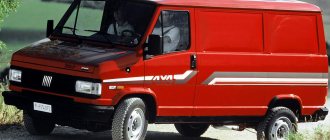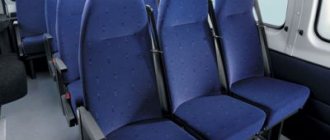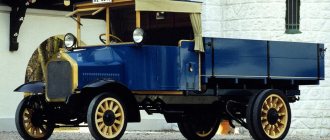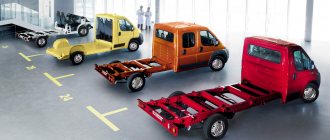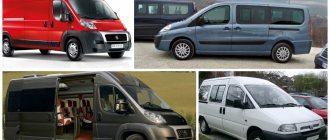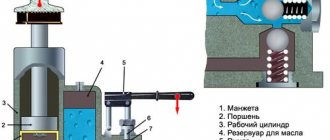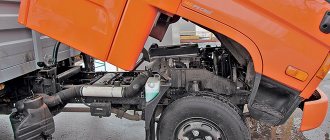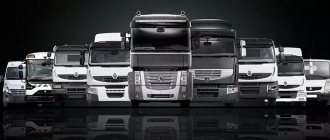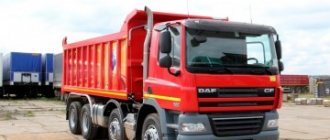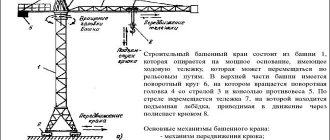| Full title: | Fabbrica Italiana di Avto mobili Torino |
| Other names: | FIAT |
| Existence: | July 11, 1899 |
| Location: | Italy: Turin |
| Founders: | Giovanni Agnelli |
| Products: | cars |
| The lineup: | Fiat Ulysse; Fiat 600; |
The founding of the FIAT company occurred at the very end of the nineteenth century. Its first enterprise was opened in 1900. The initiator and one of the people who dared to invest their own funds in creating the company was retired officer Giovanni Agnelli. Two years after the launch of the first plant, Agnelli headed the company, taking the position of managing director.
Company `s logo
The now well-known name of the company is formed by the initial letters of its full name, which sounded like this: Fabbrica Italiana di Avto mobili Torino. The first cars had the full name on them. It was applied to a metal plate, designed in the form of a parchment sheet. For a memorable logo, a few words were not the best option. Apparently, this is why the phrase was abandoned in favor of the abbreviation “FIAT”. These four letters (mostly in white) were placed on a red or blue background. This went on for many years. For example, on cars produced in 1999, the logo was blue, and on those that appeared in 2006, it was red.
Production development
The first car assembled at the Turin plant was not FIAT’s own, but a licensed “French” Renault, equipped with a “De Dion” engine.
The Italian enterprise significantly increased its capacity after import duties on steel were abolished in 1903. Since that time, the range of manufactured equipment has been replenished with passenger cars - taxis, buses, trucks. In addition, the plant assembled engines for water and air transport.
The company's products were in great demand, including due to their low cost. This circumstance made it possible to sell it outside of Italy. Having mastered the European markets, FIAT “moved” overseas to the United States. There, in 1908, his branch, Fiat Automobile Co., opened.
The company began producing cars of its own design only in 1912. We must pay tribute to the head of the Turin Automobile Factory. It was he who became the first automaker to develop the idea of automotive design. He believed that the appearance of a vehicle is no less important than its “filling”.
The year 1916 was remembered in the history of the FIAT brand for the start of construction of a new production complex. “Lingotto” (as the plant was called) became the largest European enterprise (and the second largest in the world). The building consisted of five floors. A track was set up on its roof where cars were tested.
The company developed rapidly at the beginning of the last century. It acquired ownership of electrical networks, began smelting steel, and began producing railway vehicles.
Even the difficult years of the world wars did not significantly affect the Italian corporation. At this time, the production of passenger cars decreased significantly, but the demand for freight transport (road and rail), as well as components for aircraft, increased.
The construction of the company's next plant (Mirafiori) began in 1937. After the end of the war, this enterprise became twice as large as it was intended during construction.
Later, the company continued its development, in particular, in the second half of the last century, it acquired the “Robogate” robotic line, on which bodies were assembled. In the last decade of the last century, to address issues of competitiveness, the company entered into untapped markets.
What FIAT was first at
It turns out that before FIAT, no one installed such important systems as heating and ventilation on cars.
Products with the FIAT logo have been awarded the title “Car of the Year” on the European continent twelve times. No other car company can boast of such success.
One of these “Cars of the Year” - FIAT 124, recognized as the best in Europe in 1967, was chosen by Soviet leaders as the prototype of domestic VAZs.
In 1951, FIAT released the first SUV with a so-called monocoque body. It was FIAT Campagnola.
FIAT developed the fuel supply system for the Common Rail engine together with. This system was first used in 1986 on the FIAT Croma car.
For the first time, a cardan transmission was “noted” on a FIAT car.
FIAT was one of the first to resort to the services of separate body shops.
An interesting historical fact: a Soviet city was named after the Italian Palmiro Togliatti, one of the organizers of strikes at the FIAT plant in the 19-20s of the last century. It was there that an automobile plant appeared, which began work by converting the FIAT 124 into a domestic “penny”.
FIAT in motorsport
FIAT cars took part in prestigious races and often became winners. And this despite the fact that the company’s first sports car appeared only in 1933. The 508S sports car was essentially a slightly modified version of the Balilla passenger car. That same year, at the Mille Miglia race, he “climbed” to the third step of the podium.
After 33 years, the company created the FIAT Dino sports car. The car received its name after the son of the famous racer Enzo Ferrari. Later, another Dino appeared - “Ferrari Dino”. The two cars were not much different from each other.
FIAT's sporting victories also include those that went to Maserati, Ferrari, Alfa Romeo and Lancia, because these companies were part of it.
FIAT is proud of its famous drivers: Michael Schumacher and Kimi Raikkonen.
Unforgettable models
Giovanni Agnelli did a lot of magic on the first Tipo Zero model, trying to make it different from most cars of that time. To do this, he instructed his subordinates to develop as many as six different radiator grilles.
Designed for four seats, the FIAT-409 went into production in 1912. Since that time, the company has set its sights on producing cars for a wide range of consumers.
In the thirties, two models appeared at once, distinguished by their compactness and efficiency: “Topolino” and “Balilla”. FIAT Topolino was produced for 20 years - until 1955.
The Giugiaro design studio had a hand in the development of the FIAT Panda, released in 1980. The all-wheel drive version of this car has been available since 1983. There was no all-wheel drive car with smaller dimensions. The car was so-so, but it was inexpensive, and therefore was in considerable demand.
The FIAT Uno model deserves special attention. It embodied all the advanced technical achievements of its time available to the company.
The unusual FIAT -500 car from 2007 was especially popular among the “weaker sex”, despite its high cost (and, perhaps, because of it).
FIAT on the Russian market
Already in 1916, Italian Fiat 15 Ter trucks began to be assembled on Russian territory. Having thoroughly studied the machine, domestic designers created their own design, and production workers launched its production.
Fiat specialists helped build the Volzhsky Automobile Plant.
In our century (2006 -2011), Fiat models “Ducato”, “Albea” and “Doblo” were produced on Russian territory. The Italian company plans to build an automobile plant in the Leningrad region.
Tuning of Ducato SUVs can be ordered on this website.
It cannot be said that FIAT products are in great demand among Russians. Many foreign cars have appeared on domestic markets, and Italian ones are inferior in quality to many. We have very few dealer networks of this company. For these reasons, FIATs are rarely seen on Russian roads. But Russian-assembled commercial vehicles are quite popular.
Time will tell what the future fate of Fiat products in Russia will be.
Fiat Group is an Italian manufacturer of passenger and commercial vehicles, engines, and auto components. The headquarters is located in Turin.
Since 2011, the company has been divided into two subsidiaries: Fiat SpA, which produces passenger cars, and Fiat Industrial, which produces vehicles for industry.
In 2014, when the Italian automaker bought 100% of Chrysler shares, it was decided to create a single company, Fiat Chrysler Automobiles, whose headquarters would be located in the Netherlands.
The company was founded by Giovanni Agnelli along with several investors in 1899. The first car was the Corso Dante 35 with a 3.5 hp two-cylinder boxer engine placed at the rear. In 1900, the brand's first factory opened in Turin, employing 150 people, with a production capacity of 24 cars per year. When Agnelli visited Henry Ford's enterprises, Europe's first automobile assembly line appeared at the Turin plant.
Since 1901, the engine began to be placed in the front of the car. The first model with the new layout was the 8 PS, which received a three-speed gearbox and mechanical brakes on the rear wheels. The liter engine could accelerate the car to 45 km/h.
Fiat 8 PS (1901)
A year later, a 4.2-liter four-cylinder engine appears, and Giovanni Agnelli wins the Giro de Italia Automobilistico. In 1903, the first 18 BL truck was produced. The following year, the wooden frame was replaced with a steel one, and a batch of luxury cars with a 10-liter engine producing 60 hp was released.
In 1908, Fiat cars began to be exported to the United States. Around the same time, the brand's taxis became very popular in Europe.
In 1916, construction began on a plant called the Automobile Moscow Society (AMO) in Moscow. At this enterprise, entrepreneurs Ryabushinsky began to assemble Fiat 15 Ter cars. Before this, the Fiat-15 bis, which took part in a military vehicle rally in 1912, was popular among the Russian public. In 1918 the enterprise was nationalized. Since 1924, the plant produced the Soviet AMO-F-15 truck, built on the basis of the Fiat-15 Ter.
During World War I, Fiat produced aircraft engines, machine guns, trucks and ambulances. In the post-war years, the company returned to car production, produced its first tractor, and by the early 1920s it had an 80 percent share of the car market in Italy.
The company conducts experiments with the compressor, which results in the development of a 12-cylinder V-twin engine with 187 hp. A car equipped with such an engine accelerated to 240 km/h.
In 1921, the company sought to conquer the luxury car segment with the release of the 520 Superfiat, which was the only car in the world with a V12 engine. However, it was not popular with buyers: from 1921 to 1923, only 30 units of the model were built.
Fiat 520 Superfiat (1921-1923)
In 1925, the 509 was released, an inexpensive, reliable car that featured the first rear-mounted camshaft. Until 1929, about 90,000 units of the model were sold. In 1927, the first Fiat car with hydraulic brakes, the 521 C, appeared.
In the early 30s, the market needed inexpensive cars, so the brand developed the budget 508 Balilla. It was distinguished by revolutionary low fuel consumption (8 liters per 100 km) and reliability. Equipped with a 1.0-liter engine producing 20 hp. the car accelerated to 85 km/h. Over the entire production period, Fiat produced 113,000 copies of the model.
In 1935 in Milan, the company introduced a car using an aerodynamic body, a central tubular frame, Dubonnet independent front wheel suspension and an overhead valve engine.
A year later, the legendary Topolino small car was released, which was sold at a price less than 508 Balilla. Its 0.6-liter engine developed 13 hp, but accelerated the car to 85 km/h. From now on, the brand specializes in producing inexpensive cars and abandons its ambitions in the premium segment.
Fiat Topolino (1936-1955)
During World War II, military equipment was made on the basis of civilian cars. In the post-war period, the company's factories required restoration and development of a new customer base. Due to his complicity with the Mussolini regime, Giovanni Agnelli was removed from the post of general director in 1945 and soon died. His place was taken by Vittorio Valletta, who immediately began the difficult task of restoring normal operations.
The devastation of the post-war years put auto companies in a difficult position not only for obvious reasons: destruction, impoverishment of the population, supply disruptions. It was unclear in what areas to develop, what cars to produce, what the market would require in the near future. Fiat decided to follow the beaten path and launched the 500 Topolino, which was successful even before the war. It was this car that helped her stay afloat.
In 1950, a completely new model appeared - the Fiat 1400 with a monocoque body designed by Pininfarina. The car received a short-stroke engine with a cylinder diameter of 82 m and a piston stroke of 55 mm. Later, he became the first car of the brand to receive a diesel engine.
A year later, the 1900 model comes out, as well as the first Campacnola SUV. In 1952, the 8V sports car was introduced, which became the first car of the brand with independent suspension on all wheels. The body design was developed by Ghia. This model could accelerate to 190 km/h.
In 1955, the 500S Topolino was replaced by the 600, a budget car that became truly popular due to its affordable price. It was this model that Soviet designers used to create the design of the first Zaporozhets. The Fiat was equipped with a 600 cc air-cooled engine producing 22 hp. With modest technical characteristics, it could accelerate to 100 km/h and could accommodate four people inside.
Fiat 600 (1955-1969)
In 1961, a new family of rear-wheel drive cars appeared, designed by designer Aurelio Lampredi, who previously worked at Ferrari. They also became inspirations for Soviet designers: many elements were used on Moskvich-408.
1966 was the year the Fiat 124 appeared, which immediately won the Car of the Year competition. Later it was used in the design of the VAZ-2101, 2102 and 2103, the first mass-produced Soviet cars. The Italians were engaged in the construction of the AVTOVAZ plant and equipped it with equipment.
In 1969, thanks to lucrative contracts with the USSR and Poland, the company felt financial confidence to begin acquisitions. First of all, she buys Lancia and Ferrari.
In 1972, the 131 Mirafiori replaced the 124 model. It was distinguished by a modern design and a range of different trim levels. Then comes the subcompact 126, which has become a cult classic.
In 1980, the brand introduced a new program, the first car of which was the angular Panda. In 1985, the Croma front-wheel drive sedan was released, developed jointly with Lancia and SAAB. The model was equipped with in-line four-cylinder gasoline engines, including turbocharging. Diesel engines were also offered.
Fiat Panda (1980)
In 1986, the company bought Alfa Romeo and merged it into a new division, Alfa Lancia SpA.
In the 1990s, Italian automakers began to lose ground to competitors. Fiat was forced to leave the North American market due to the loss of credibility associated with the unreliability of cars. In 1995, the company bought Maserati, however, despite owning a 90 percent market share, the situation worsened. In 2002, the company suffered record losses of 4.2 billion euros.
In 2004, Sergio Marchionne became the head of the company, and the following year the brand became profitable again. The company does not concentrate on political and trade union issues, but on the development of the automobile business. The success of the brand is largely dictated by two models - Fiat 500 and Fiat Panda. With these cars, the Italian automaker returned to the markets of Canada, the USA and Australia.
On January 20, 2009, Fiat SpA and Chrysler LLC announced their intention to create a global alliance. On January 1, 2014, Fiat became the owner of the American brand.
Today in Russia the interests of the brand are represented by Chrysler RUS CJSC. The assembly of Fiat Albea and Fiat Doblo models (Naberezhnye Chelny), as well as Fiat Ducato (Elabuga) was carried out.
In 2010, the Italian automaker intended to create a joint venture between Fiat and Sollers as part of a project. The planned capacity of the enterprise was 500 thousand cars annually. The Russian government could provide a loan of 2.1 billion euros for the implementation of this project. However, a year later the parties refused to implement it.
In 2013, Fiat was named the second largest automaker in Europe by production volume and seventh in the world. The company produces vehicles under the brands Abarth, Alfa Romeo, Chrysler, Dodge, Ferrari, Fiat, Fiat Professional, Jeep, Lancia, Maserati, Ram Trucks and SRT. The brand is a market leader in Brazil, where the second largest plant is located after Italy. Fiat's operations are also located in Argentina, Poland and Mexico. Numerous alliances and joint ventures make it possible to assemble cars in Serbia, France, Turkey, India and China.
Today it is a huge concern that produces a wide range of equipment intended for construction, agriculture, freight and passenger transportation, as well as passenger cars for road and sports purposes. It was founded in 1899 by a group of businessmen, but the original name was not so short - “Societa Anonima Fabbrica Italiana Automobili Torino”. In the first years of its existence, the company was engaged in assembling Renault cars, but already in 1903 it began to rapidly expand its scope of activity, and first took on trucks, and then passenger buses. In addition, the abolition of duties on the import of steel from abroad allowed it to even begin producing ship and aircraft engines.
Fiat passenger cars were initially produced in small quantities as prestigious and expensive cars. However, due to their high quality and regular victories in various auto races, they were sold very widely. One of the most impressive victories of that time was won by the Fiat S61 in 1911 at the French Grand Prix. It is worth noting that the engine of this model had an incredible volume of 10.5 liters.
In 1912, the development of large-scale Fiat passenger cars began. The owners of the company wanted to launch on the market not only high-quality, but also original cars that would stand out against the background of any tricks of competitors. In order to have a wide selection of bodies for their products, they enter into contracts with a number of coachbuilders - Zagato, Locati & Toretta and Touring. In 1916, construction of the Lingotto plant began, which lasted 6 years. This production complex became the largest that existed in Europe, and was designed to provide conveyor production of passenger cars.
The first model to gain wide recognition was the Fiat Balilla, released by the concern in 1932. It had very low fuel consumption and low cost, which made it widely available. 4 years later, the Fiat Topolino was released, compact and even cheaper, repeating the success of the previous one.
During World War II, air strikes destroyed most of the company's production facilities, and the remainder were nationalized. In conditions of post-war shortages, Fiat management made the right bet on producing cheap and economical passenger cars, releasing updated models one after another. In 1950, the first diesel car, the Fiat 1400, was released.
In 1966, Fiat entered into an agreement with the Soviet Union, and the Volzhsky Automobile Plant was built in Togliatti, which initially produced Fiat models under its own name. Thus, the well-known “kopek”, or VAZ-2101, is almost identical to the Fiat-124 released in 1967.
In 1969, Fiat bought it from the owners. The years of the oil crisis that followed did not lead the company to collapse, but only forced it to focus on increasing production efficiency and monitoring product quality and its efficiency.
In 1980, the Fiat Panda was introduced, designed by the famous Giorgetto Giugiaro. The car was very inexpensive, but at the same time it was of high quality and easy to repair in case of breakdown, which made it a bestseller in Europe. Panda cars can be seen on the streets of Europe even today. The Fiat Uno, released three years later and featuring many updates to electronics, engine components and other aspects, became no less popular.
In 1986, Alfa Romeo came under the control of the Fiat concern after purchasing a controlling stake in this company.
Fiat's new bestseller, the Punto hatchback, was released in 1993. It was produced in several variations - covered with 3, 5 doors, a convertible and a Gran Turismo modification, which had the maximum configuration.
In 2003, a new Fiat Punto appeared, equipped with an innovative 1.3 Multijet 16v engine, and the Barchetta was also updated.
In the fall, the new Fiat Panda was released and received the title “Car of 2004.”
In 2004, the Fiat Idea went on sale, which became Fiat's first universal car, as well as the first car entrusted with promoting the brand's new mission. This car has a unique design.
In 2006, Fiat changes its logo again. It was developed together with the Robilant Associati agency and the Fiat Style Center.
Today the concern produces equipment for industrial and civil needs, and is one of the largest automakers.
In 2007, a presentation of the new Fiat 500 model was held in Turin. The date of the premiere was not chosen by chance, because it was on July 4, fifty years ago, that the company launched a new machine of the same name, which is associated with the formation of a new generation. The new product, in fact, was a modernized and improved version of the Fiat Panda. The Fiat 500 was equipped with two powerful gasoline engines of different sizes (from 1.2 to 1.4 liters) with a power of up to 100 horsepower. All units operate on a six-speed or five-speed gearbox. Environmentalists should be delighted with this vehicle, because its engines fully comply with Euro 5 standards.
In 2015, Fiat Bravo ceased to exist, as demand for it in our region fell sharply. Despite this, the modernized, roomy Bravo hatchback is selling very successfully in South America. This model is the closest “relative” of the Centro Stile Fiat, released back in 2007. Only now the model has received new bumpers, wheels, a convenient touch screen, wheels and a comfortable steering wheel.
In Brazil, the Fiat Bravo, unveiled in January 2015, will only be an interim option before the Fiat-Chrysler launch in 2016. It is worth noting that more than a billion dollars have already been invested in the latter’s project, part of which will be used to expand the capabilities of the largest plant of this brand in Minas Gerais.
Every year the concern bought bankrupt companies and today under its “roof” there are not only the automobile companies FERRARI, ALFA ROMEO and LANCIA, but also a couple of factories specializing in the production of specialized equipment, namely tractors.
Cars from Italy in Russia are valued primarily for their elegance and practicality. Italian roots are clearly visible in the largest Russian one. The Togliatti VAZ-2101 is actually well known in Italy.
In this article we will look at the issues of Russian-assembled Fiat models and remember a little about the history of the brand. How good and popular are Fiats in Russia? What cars from Italy are assembled in the Russian Federation? We will also look at the main advantages and disadvantages.
THE RUSSIAN DUCATO HAS ENTERED THE SERIES!
(the new name of Sollers) has implemented another ambitious project: on May 27, mass production of the Fiat Ducato light commercial vehicle was officially opened in Yelabuga, which promises to become the most popular on the Russian market among foreign cars of this class and, perhaps, will compete even with the GAZelle. The production capacity of Sollers-Elabuga is designed to produce 75,000 cars per year!
An old horse won’t spoil the furrow... However, let’s make a reservation right away: the car put on the assembly line in Yelabuga is the Fiat Ducato of the previous, second generation (1994-2005), which Sollers, however, recommends as a “new Russian-made commercial vehicle.” A very diplomatic remark (for “Russian production” it may indeed be new), although they could honestly admit: yes, the platform is slightly outdated, but it is proven and tested. They could also remind you that at one time the Fiat Ducato II (together with its “twin brothers” Citroen Jumper and Peugeot Boxer) made a splash in Europe and won the Van of the Year title. But that was a really long time ago - in 1994. The appearance of Ducato II was a real breakthrough in the commercial vehicle market. Front-wheel drive (unusual at that time) and a transversely mounted engine made it possible to make the floor of the cargo compartment very low and make maximum use of usable space; instead of the traditional gearbox “poker” on the floor, a joystick appeared on the dashboard; the smallest overhangs among its competitors, which make it possible to drive close to the curb, drive onto a ramp, etc., made the car highly maneuverable and maximally suitable for work in the city - thanks to all these features, the Fiat Ducato II acquired the image of one of the most versatile in its class (vans total weight 2.8-3.5 tons). The car was very popular, as evidenced by sales figures - the most objective criterion for the success of any model. During the entire production period, Ducato II sold almost two million copies: 1,227,094 cars in the X230 body (1994-2002) and 758,565 restyled X244 (2002-2005) were sold. Since 2006, the Italian SEVEL plant (it belongs to the Fiat-PSA Peugeot Citroen alliance) launched the third generation Fiat Ducato (factory index X250), and the Russian Severstal-Auto acquired the license to produce the X244. This car will be produced in Yelabuga. The choice is explained simply: the cost of the previous generation Ducato is significantly lower than the new one. The new Ducato III will be imported from Italy, but only in expensive top versions.
Full cycle Why is the “Russian Ducato” project arousing such keen interest? Are there not enough enterprises in Russia that are quietly assembling “overseas” cars? But the fact is that Severstal-auto (Sollers) intends to localize the entire production chain for car production. Welding, painting, assembly - all this is available at the site in Yelabuga. The next step is the organization of stamping production here, which should start operating this year. In general, as Vadim Shvetsov, general director of Severstal-auto (Sollers), said at the opening ceremony, the company sets the task of transferring to Russia, within a month to a year, the production of most Fiat Ducato components and assemblies, including the engine, which accounts for almost 30 % of the cost of the car. The localization level of the project should be 90% - the figure cannot but impress. The total investment in this project, as previously reported, was to be about $150 million. The latest data: 8 billion Russian rubles will be invested in organizing car production at the site in Yelabuga, another 2.5 billion will be allocated to preparing the production of auto components. True, these figures also apply to the assembly of Isuzu trucks, which Severstal-auto (Sollers) organized at the same site in the Alabuga SEZ (design capacity - 50 thousand vehicles per year). According to Vadim Shvetsov, the production of Fiat Ducato currently employs approximately 600 people, but with the expansion of production, the staff of workers in the future may increase to 6 thousand.
model range in Elabuga is planned to be produced in 14 basic modifications with the ability to choose the length of the wheelbase and body height (3 options each). These will not only be vans and minibuses, but also chassis with regular and double cabs. In addition, the plant is going to organize the production of special series cars that will be created personally for the needs of each client. However, at the first stage (until the end of 2008), only 9 modifications of the car will be launched into the series: 4 types of vans, a combi, a minibus, as well as three modifications created specifically for the Russian market - a school bus, an ambulance and a minibus. This year 10,000 cars should be produced. The planned colors for the base versions are white, red, blue and yellow. The plant should reach its design capacity by 2012.
The modest filling of the Fiat Ducato from Severstal-auto (Sollers) is specially adapted to Russian operating conditions. All cars will be equipped with a high-power generator and a high-capacity battery, which should make it easier to start the engine in the cold season, as well as a coolant reheating system, which will guarantee quick warm-up of the engine and maintain a comfortable temperature in the cabin when the car is stopped. In addition, as a tribute to Russian roads, a standard installation of engine crankcase protection is provided for all cars. Otherwise, it’s the well-known hard worker Ducato II. Front-wheel drive, single-disc dry clutch with hydraulic drive. Power rack and pinion steering, 5-speed manual transmission. The front suspension is independent, McPherson type, with anti-roll bar; the rear is a rigid beam with longitudinal leaf springs. Front disc brakes; rear - drum on short and medium wheelbase versions and disc on long wheelbase. The “stuffing” in the basic versions is very modest. Vans do not have ABS or driver airbags. Among the “bells and whistles” in the “standard” there is only an immobilizer and height adjustment of the steering column. Minibuses are equipped with ABS as standard, plus two-point seat belts for passengers. But the driver's airbag is only available in the High trim level. The carrying capacity of the van, depending on the version, varies between 990-1505 kg, and the internal volume of the cargo compartment is from 7.5 to 14 cubic meters. m. Passenger capacity of the minibus is 15 people. All Russian-assembled Fiat Ducato are currently equipped with one single engine, although seven engines were once offered for the Italian Ducato II. In Elabuga, cars are equipped with a reliable and unpretentious in-line diesel engine F1A 2.3JTD 16V (volume - 2.3 l, power - 110 hp (81 kW), torque - 270 Nm at 1800 rpm), which meets the environmental standard Euro-3. Its distinctive feature is its design using an intercooler and direct fuel injection system (Common Rail), which provides the car with good fuel efficiency: 7.8-8.5 l/100 km in the combined cycle for vans and 8.4 l/100 km for minibuses. Sollers gives its Ducato a two-year, unlimited mileage warranty. Service interval - 15 thousand km.
Competitors The GAZelle challenge, which was discussed at the very beginning, is not a joke. Yes, Ducato costs more - 489,900 Russian rubles for the most modest model (short wheelbase, low roof, cargo compartment volume - 7.5 cubic meters). The price of a GAZelle van starts from 330,000 Russian rubles. However, Ducato has a trump card - an economical diesel engine, which will be equipped in all cars without exception. Plus moderate maintenance costs. Analysts at Severstal-auto (Sollers) calculated that one kilometer of Ducato mileage will cost the owner $0.13, while the cost of one kilometer for the “average Russian analogue” is $0.17. Consequently, the total cost of owning a Fiat Ducato over 120 thousand km will be 35% lower than the cost of owning “Russian analogues” (it’s probably clear what kind of cars they mean). Of course, one could argue that the calculations were made by interested specialists who, in their calculations, compared the Ducato with a gasoline GAZelle, although GAZ also produces a diesel version. On the other hand, diesel GAZelles are a drop in the huge sea of ordinary light commercial vehicles rolling off the assembly line in Nizhny (210,419 light commercial vehicles were produced here in 2007). Mass dieselization is once again postponed: the year is called 2009, but GAZ does not yet have its own diesel engine. But the Maxus, produced by the British company LDV (owned by the GAZ Group since 2006), could indeed compete with the Russian Ducato: it also has front-wheel drive and a diesel engine and in its basic configuration today costs only 504 thousand Russian rubles. However, this price, apparently, is stated in anticipation of the promising (from mid-2009) Maxus assembly in Nizhny Novgorod - cars manufactured in Birmingham and imported to Russia are unlikely to cost half a million rubles simply because they cost from 17 thousand pounds (more than $33 thousand). As for other small-tonnage vehicles imported to Russia, the Ducato from Elabuga is both cheaper and has a lower cost of ownership - about 20% less than the closest foreign analogue (again, according to the calculations of Sollers specialists).
Sales Severstal-auto (Sollers) intends to sell Fiat Ducato on the Russian market through 51 authorized dealership centers in 29 cities. By the end of the year, the car will be presented in 42 cities of Russia, the number of auto centers will increase to 110. It is planned that more than 10% of sales will be carried out through its own leasing company Sollers Finance, which will be able to offer customers a flexible payment schedule and competitive rates. Sergey BONDAREV.
*** Godfather Putin... The “Godfather” of the Russian Fiat Ducato was the Prime Minister of the Russian Federation Vladimir Putin, who took part in the official opening ceremony of mass production of cars in the Special Economic Zone “Alabuga” together with the President of Tatarstan Mintimer Shaimiev, General Director of Severstal -auto" Vadim Shvetsov and vice-president of Fiat Ezio Barra.
*** New name - official Since May 22, Severstalavto-Elabuga LLC, which produces Fiat Ducato commercial vehicles, has officially received a new legal name, Sollers-Elabuga LLC. OJSC ZMA, which produces Korean SsangYong SUVs and Fiat cars, was also renamed: its new name is OJSC Sollers-Naberezhnye Chelny. Let us remind you that the new Sollers brand was developed to rename the parent company of the holding, its car assembly plants, as well as to promote the project to create its own dealer network and develop new types of services for customers. The official renaming of OJSC Severstal-auto into OJSC Sollers is expected in June.
*** Engineering Academy An educational academy will be created in Yelabuga, which will train qualified engineers and technical specialists for the automotive industry. The protocol of intent to organize this educational institution was signed by the General Director of Sollers (Severstal-auto) Vadim Shvetsov and the Vice President of Fiat Ezio Barra. The Academy will be created with the assistance of the Turin Polytechnic Institute (Italy).
Fiat and associations
What first comes to mind when you hear Fiat? The musical sound immediately says that the country is Italy. In fact, the history of this famous company is closely connected with the history of Russia. Something has always drawn Italian manufacturers to Russian spaces. And it’s not for nothing that VAZ is a pure Italian.
It’s surprising that Fiat has not gained a foothold in our country over the subsequent years. Yes, there was cooperation with Sollers. But it did not last and did not grow into something more. Already in 2011, the cooperation, which lasted 5 years, ceased. During this time, the production of “local” Fiat Albea, Fiat Doblo and Fiat Ducato was established. The process of manufacturing cars was reduced to assembling ready-made components imported from abroad. At the same time, cars of our assembly sold well and were very popular.
The Italians are not discouraged and are boldly building prospects for cooperation. Most often, their ambitious proposals contain figures for car production of approximately 500 thousand per year and at a newly built plant.
A little history
The history of the company began back in 1899 in the city of Torino, in northern Italy. In the first car from Fiat, the driver sat in the back and the passengers sat in front. Control was carried out using levers. The steering wheel appeared later. Since 1911, the company has been trying its hand at producing racing cars. The successful release of S76 allowed us to continue and develop this direction.
The desire to develop and experiment led Fiat to create a huge empire. Today Fiat is a manufacturer not only of cars of all types and purposes, but also of aircraft, trains and engines for ships of various displacements and purposes.
And then, back in the last century, the company took on any undertaking. During the war, Fiat mastered the production of aircraft, tanks and armored vehicles. Since the late 60s, Fiat has become a corporation that includes Ferrari, Lancia, Alfa Romeo and Maserati.
In 1999, Fiat celebrated its centenary. Today, the global technology manufacturing concern can hardly be called decrepit. More than a century of constant development has strengthened Fiat and given it a good impetus. New concepts are constantly being designed and modern vehicles are being introduced into service. More than 130 of our own research centers around the world are actively helping.
Main production facilities
In modern reality, the size of the Fiat corporation is impressive. Under the common wing there are more than 1,000 companies in 61 countries around the world. The number of Fiat employees is about 220 thousand, of which half work outside the borders of Italy. As a percentage, about 46% of all production capacity is located outside the homeland.
Fiat has its own factories in Brazil, Argentina and Poland. At the same time, the Brazilian production site is the largest. At maximum load, the car plant is capable of producing 3,000 cars per day! The country is not only Italy. There are many joint ventures in France, Egypt, South Africa, Turkey, China and India. Cooperation is structured differently everywhere. Somewhere, as was the case in Russia, only assembly is carried out from components imported from Italy, but somewhere in one plant they can assemble both Fiat and local equipment.
The concern plans to further expand into the markets of Africa, Europe and America. After all, the main concept was and remains that as many people as possible become familiar with the most advanced technologies thanks to Fiat cars.
Fiat assembled in Kaluga will appear in a year, but Russians may not see it
The Stellantis concern intends to increase the production volume of Peugeot, Citroen and Opel cars at the Russian plant eightfold for export sales. In fact, the Dutch concern (which included Fiat Chrysler Automobiles (FCA) and Groupe PSA) is the first foreigner to create a local export hub in the Russian auto industry. Among other things, commercial Fiat models will be produced in Kaluga for foreign markets. Experts doubt that the declared supply volumes will be achieved in the near future.
Fiat cars will be produced in Kaluga, Xavier Duchman, senior vice president and director of the Eurasia region of the Stellantis alliance, said on Tuesday, July 20. In 2022, the Fiat Scudo commercial vehicle will enter the assembly line of the Russian assembly plant.
“We plan to increase Stellantis production eightfold within two years at this plant and need to use it to the maximum - both for export and for the local market,” Xavier Duchman told Gazeta.Ru.
Kaluga-assembled vehicles are planned to be exported in a volume of up to 30-35 thousand units per year. The export hub also involves the shipment of Russian-made engines to Europe, Latin America and North Africa. Now diesel engines with a displacement of 1.6 liters are assembled in Kaluga; cylinder blocks for the plant are supplied by a Nizhny Novgorod supplier.
In 2022, PSMA Rus produced only 22 thousand cars - 45% more than at the end of 2019. Moreover, this number also includes Mitsubishi brand models (the Japanese company owns 30% of the plant and has the right to use a third of its capacity).
The Fiat Scudo, the production of which Stellantis plans to launch in Russia, is structurally close to the Peugeot Expert, Citroen Jumpy and Opel Vivaro vans and minibuses - they are built on a common K-Zero platform. These cars are larger than the heels of the Peugeot Partner and Citroen Berlingo (built on a different B9 platform), but smaller than the Fiat Ducato, a classmate of the Russian Gazelle.
But you won’t be able to buy a Russian-assembled Fiat Scudo in Russia – at least in the near future. Other members of the K-Zero family under the Peugeot, Citroen and Opel brands are already produced and sold in our country.
A final decision regarding sales of Russian-assembled Fiat Scudo in Russia has not yet been made, Dushman clarified. However, the priority for Stellantis was the development of production of these machines in Russia specifically for export - and the company’s plans in this direction look very bold.
According to the top manager, taking into account the above models, the concern sets itself ambitions to achieve first place among exporters of cars to Europe from Russia.
At the same time, the company will strive for maximum localization of production in Russia - despite the difficulties in finding suppliers. It is possible that stamping of body parts will also be carried out in our country. However, the alliance representative did not give specific dates for the implementation of this operation.
The fact that Stellantis is betting on light commercial vehicles (LCV) is the right decision: in Russia this segment is in demand and is not as volatile in price as passenger transport, notes independent automotive industry consultant Sergei Burgazliev. In addition, the LCV segment is not so saturated with competitors, he believes.
If we provide an attractive price for such cars in Russia, they may well find their niche, the expert believes. At the same time, it is quite possible to make cars of this family inexpensive, given the popularity in Europe and large circulations. Assembly in Russia is also not very expensive, Burgazliev points out. At the same time, the figure of 30 thousand cars per year for export supplies seems overly optimistic.
“These are very large volumes for export, simply colossal. In the short and medium term, I don’t really believe in achieving these indicators,” Burgazliev doubts.
The prospect of localizing Opel passenger cars in Russia also depends on success in the commercial vehicle market. The German brand, acquired by Peugeot-Citroen, is now also part of Stellantis.
“Among other ideas, we are also considering the possibility of localizing some Opel models here in Russia,” Dushman emphasized. “We are convinced that Opel in Russia has very good potential.”
Fiat model range
Production of Russian Fiats ceased in 2011. Since then, new Doblo, Albea and Ducato cannot be purchased. What can Fiat please Russians with today? In 2016, the automaker’s lineup is limited to only 3 cars:
- punto;
- FullBack.
The 500th Fiat, whose manufacturer is its native Italy, is a neat and compact hatchback. The car can have either a 1.2-liter petrol power unit, a 0.9-liter turbocharged engine, or a 1.3-liter diesel engine.
The Punto is a modest hatchback that also has a choice of two power units with 1.4 liters but different power. As for, two transmission options are offered: classic mechanics and robotic automatic.
FullBack is a clone of the Japanese car. The all-wheel drive car, produced at the production site in Thailand, perfectly complements the Fiat range of cars. But for this car, the question: “Fullback Fiat” - which country is Fiat?
Despite the fact that today there are no joint productions with Fiat, there are cars that deserve special attention. These are the Albea, Doblo and Ducato we love so much. Cooperation with was not in vain. The Ducato has been the most popular car in its class for several years.
Despite active and successful sales of Russian Ducato and Doblo, there was a lot of criticism towards our assembly. In some places we noticed gaps larger than those provided by the factory, in others there were defective products in the car. However, criticism did not prevent the cars from becoming popular. Fiat Ducato, whose manufacturer is a plant in Yelabuga, simply had no competitors at one time.
Technical features
During the restyling, the Italian manufacturer decided to update the line of power units. In the Fiat introduced in 2004, only gasoline engines were left unchanged. As for diesel engines, instead of a 63-horsepower engine, a 70-horsepower turbocharged unit with a volume of 1.3 liters appeared. The 1.9L turbodiesel now has a power of 105hp. With.
The basic version of the car includes:
- power steering;
- modern audio system;
- air conditioner;
- ABS.
Attention! The latest generation cars have an extended wheelbase. They are available to domestic car enthusiasts in 12 colors. The manufacturer also provides a wide list of options and basic equipment, in particular the Bluetooth system.
Having decided to purchase an Italian Fiat Doblo car, a person must first of all receive complete information about the technical and operational capabilities of this modification. After this, he should decide whether he will buy a new car or a used car. In the latter case, you will have to enlist the support of professionals who will be able to identify all hidden defects or take the car to the nearest car service center, whose specialists will carry out diagnostics.
Fiat Doblo
This model was produced in Naberezhnye Chelny when Fiat actively collaborated with Sollers. When developing this model, the designers took Fiat Cargo as a basis. The resulting compact car immediately found its connoisseurs. He liked him in Russia too. offered several modifications, which included passenger, cargo-passenger and purely cargo options.
The car had a 1.4-liter power unit, 77 “horses” and was equipped with a 5-speed gearbox. Fiat Doblo's manufacturing country seems to be Russia. Why “seemingly”? Because we only assembled the main components, which, in turn, were manufactured at the Fiat subsidiary in Turkey.
Advantages of the car
If a person needs a car for the constant transportation of goods, then he should turn his attention to Fiat Doblo. The machine has the following advantages:
- Large carrying capacity, thanks to which the vehicle can be used for commercial activities.
- Easy access to the cargo area. The owner of the car will be able to unload and load through the rear hinged doors without much difficulty.
- Modern design and practicality. This ideal combination allows you to use the car not only for business, but also as a family car.
The luggage compartment with the rear seats folded increases to 3,000 liters
Fiat Albea
It was with “Albea” that the production of “Russian Italians” began. The first car was released at the plant in Naberezhnye Chelny in 2007. It was a classic sedan of the simplest appearance. The power unit was a 1.4-liter engine. Since 2011, the car has ceased production due to obsolescence.
Many car enthusiasts did not like the rather weak and undynamic engine, as well as the simple external and internal design. Yes, it was a budget car, but time has its own demands. For the same money, competitors are already developing more modern bodies and “stuffing” them with all sorts of technical innovations.
The country is Russia, so the car also had positive aspects:
- spacious interior;
- comfortable seats;
- spacious luggage compartment;
- good ground clearance;
- economical fuel consumption;
- budget cost.
How to choose a car of this brand?
If a person decides to buy a car of this particular brand, he needs to familiarize himself with the general recommendations given by experts. In the case when you plan to purchase a new car, you should contact showrooms that directly cooperate with the manufacturer. Having made a purchase from them, the car owner will be able to count on warranty and service. If you plan to buy a used car, then you need to take this issue very seriously and enlist the support of professionals.
When buying a used car, you should consider the following nuances:
- Year of issue.
- Technical condition of the machine.
- Interior condition.
- External data.
- Condition of the power unit.
- The presence of obvious and hidden defects.
Attention! When purchasing a used car, you should take this nuance into account. It could have been actively used for commercial purposes, which could have caused its technical condition to deteriorate. In order not to get into trouble, you should invite a specialist to inspect the machine, who will immediately determine its operating capabilities.
Fiat Ducato Russia
At one time, the Ducato was the most popular car in its class. The Russian version from Sollers was armed only with a turbocharged diesel engine with 2.3 liters in volume and a manual transmission. 244 car body became the Russian designation. Just like in its time in Europe, the Ducato was produced in several versions: purely cargo and cargo-passenger. At the same time, there were elongated bodies.
The comfortable and practical Fiat Ducato, whose country of origin is Russia, had good dynamics and a comfortable interior of a foreign car. Among the shortcomings, it is worth noting some confusion when selecting spare parts. But this problem existed for everyone at first. The spare parts catalogs simply did not have time to be finalized.
Some information about the manufacturer
The Fiat brand belongs to an Italian company that has been developing and producing cars for many years. Over the years of its existence in the world market, this automaker has been able to compete with world-famous brands. The Fiat brand cars presented to the world public have the following distinctive characteristics:
- high quality;
- multifunctionality;
- capacity;
- comfort;
- excellent performance characteristics;
- presentable appearance, etc.
Attention! Currently, this manufacturer occupies a leading position in the local market in terms of sales of passenger vehicles. Also, cars of this brand have become very popular in Europe and the Russian Federation in recent years.
Comfortable and safe trips
Updated and modern Ducato
Among commercial vehicles, Ducato has always been renowned for its versatility and convenience at affordable prices. The sixth generation Ducato is no exception. Italian engineers have combined the incompatible. Commercial cargo transport can be easily and simply combined with a comfortable and technically equipped passenger car. Several modifications of the new Ducato allow you to solve a wide range of business problems. The “strongest” version of the car can lift up to 4 tons of payload.
What exactly is new in the Fiat Ducato? According to Italian developers, the car's body and door structures have been strengthened. The suspension, brakes and clutch are also strengthened and redesigned for longer service life. Among the know-how are modern white paintwork, as well as a redesigned turbine, which allows the car to accelerate even faster with less fuel consumption. Per 100 km, the 6th generation Ducato consumes only 7.3 liters of fuel.
famous not only for its cars. The concern's products include many agricultural machines and equipment, as well as a line for the production of magneti marelli spare parts.
Some historical facts that may be interesting include:
- Fiat had the first heating and ventilation system;
- the first SUV is also Fiat - Campagnola;
- the famous Common Rail injection system was developed by Fiat and Bosch;
- Fiat Sedici and Japanese are manufactured on the same basis and at the same plant.
There is information that, despite the use of advanced technologies and exquisite design, it has flaws in quality. Because of this, the name “Fiat” is translated by English-speaking inhabitants as “Fix it again, Tony.” German car enthusiasts have their own translation: “Defects in every component.” Therefore, the statement: “Country is Italy” does not always indicate the quality of the products.
External data, level of comfort and safety of Fiat
Fiat Doblo, whose technical characteristics are highly appreciated by many experts, has an appearance that is fully consistent with the latest fashion trends in the global car market:
- The front of the car is very imposing and impressive, thanks to which others get the impression of Doblo as an energetic and powerful car.
- The manufacturer from Italy equipped its “brainchild” with modern optics.
- The radiator grille, which received a V-shaped design as a gift from the developers, gives the car an elegant appearance.
- The rear of the car is made in accordance with the innovative developments of designers. The car is equipped with 2-color rear light lenses; the updated bumper has wide stripes on the sides, which provide an additional level of protection during an impact.
- Interior spaciousness and ease of entry are ensured by the high body and sliding side doors.
- Excellent handling and excellent visibility allow the driver to control the behavior of the car in any driving situation.
- The instrument panel is made in two colors; a speed mode shift knob is installed on the center console.
- The seats for the driver and passengers are highly ergonomic, which ensures maximum comfort while driving.
- The luggage compartment in its normal state has a volume of 750 liters, but with the rear seats folded down it increases to 3,000 liters.
Elegant appearance
